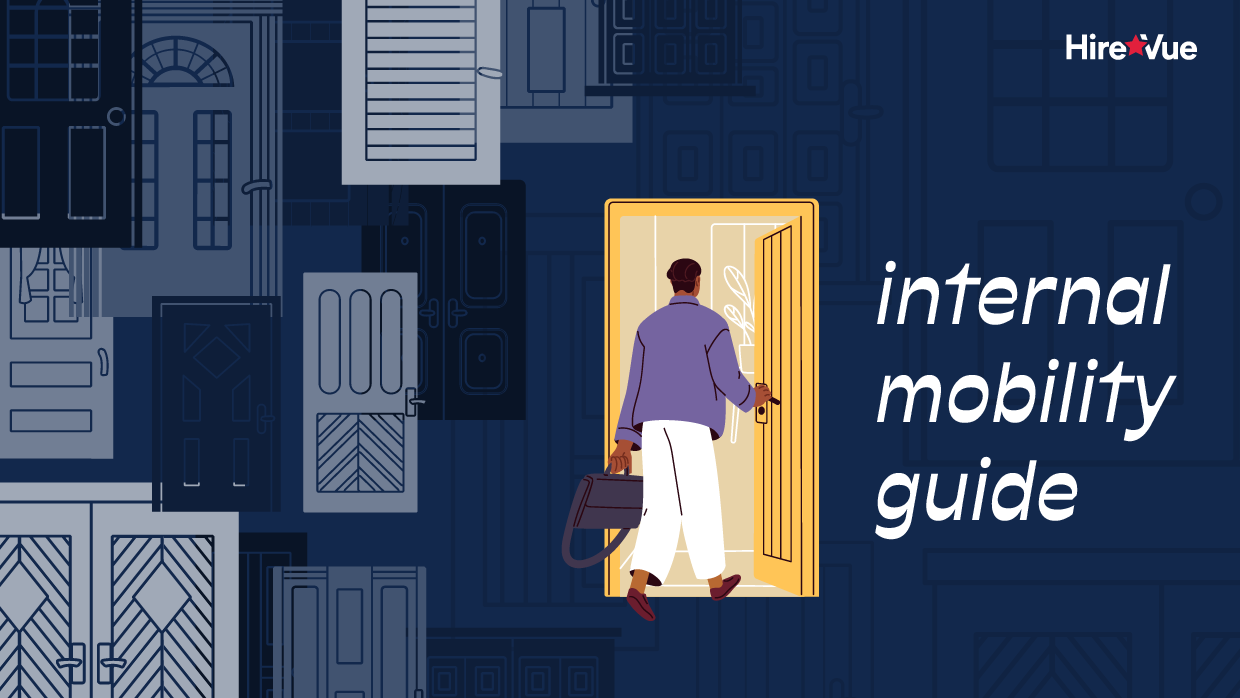Candidates: Are you interviewing and need support?
Today’s candidates have faced a tumultuous few years navigating economic uncertainty and mass lay-offs.
So it comes as no surprise that then when asked what benefits they’re looking for in a job, they cited:
- 1. Greater stability,
- 2. Financial bonuses and rewards, and
- 3. Ability to grow with the company.
According to the HireVue 2024 Global Trends Report, more than half of today’s candidates (52%) are looking for companies that promote from within and 53% have considered applying for another role at their company.
Establishing strategic and fairer internal mobility programs go a long way in not only building respectable practices but building employee satisfaction and showing you value promoting based on the right factors.
TA teams are turning to internal talent more than last year
According to the Trends Report, teams are placing more emphasis on employee well-being, which goes hand-in-hand with an internal mobility strategy. This year, 50% of TA teams say they’re turning to their internal talent for roles—compared to 44% the year before.
When candidates are asking for more stability and the ability to grow with your company, establishing internal mobility programs are critically important—processes that are fair and effective.
And while we talk so much about creating positive hiring experiences, it’s equally important that those same standards are applied to your internal mobility as well.
Candidates want stability.
Today’s landscape is still riddled with talent shortages. Three-quarters of companies find filling open roles challenging—including nearly every industry like healthcare, finance, IT, and consumer goods.
At the same time, 52% of candidates said they’re drawn to a company that promotes from within and almost the same number (53%) have considered applying for another role in their company.
Today’s landscape is unpredictable, and candidates want as much assurance as possible that their job is going to be there tomorrow—and not filled with someone else or a changed role. Internal mobility programs rooted in fairness and skill-assessment are the candidates’ gateway to job stability.
And when roles are constantly evolving, it’s important you’re hiring the right people based on the key skills they possess—and assess them on their ability to grow and change with a company. Human Potential Intelligence leans into skills-based hiring so teams can assess talent on key competencies and support smarter decisions for all roles with data.
Value your employees.
Who wants to work for an employer that doesn’t value their people? A company that refuses to look beyond who they are as employees and unlock their potential?
Candidates want to feel valued by their workplaces—and that goes for your internal talent as well. Ensure your employees believe two things:
- That people like them have a fair shot at promotions
- That promotions are given based on merit—not factors like tenure or who knows who
Ensure your hiring practices are giving everyone a shot. Lean into skills-based hiring and leave resume review in the rearview—your candidates are more than what’s on a piece of paper.
Assessments are great not just for initial hiring but when used for internal mobility initiatives as well. These tools ensure you’re hiring based on the skills that predict success—not line items on a resume. HireVue offers a complete library of assessments, formulated from IO psychology and data science best practices, to help TA teams better predict success and establish workforces that can adapt to change in the future.
When your hiring is fairer, your internal mobility processes are fairer as well. And the results are two-fold. Not only are practices more ethical but empowered employees are more productive.
They “work harder, find their work more engaging, and are more satisfied with their jobs overall.” And according to SHRM, “Employees also stay longer at organizations perceived to be places where workers have influence. After three years at one of those employers, there’s a 47 percent chance of retention, while employees at companies viewed as less empowering only have a 35 percent chance of still being there after three years, according to LinkedIn.”
And when 50% of employees have left a company because of a bad manager, the processes you use to choose new managers should be audited.
The Agile Mindset Assessment is a critical solution to measure an external and internal candidate’s ability to adapt. It works by measuring 4 key types of agility:
- People: Do they read people and interact well with new people, a variety of people, and tough situations?
- Results: Do they drive results in new or novel situations?
- Mental: Are they comfortable with complexity? Can they examine problems and make fresh connections?
- Change: Do they experiment and deal well with change? Can they deal with resistance to change?
But remember, the results may not show what you expect—and that’s okay. While it can require tough conversations, remember that some people are better suited for their current role than a new one.
Employees are people, and your practices should reflect how much you value them as humans first. Learn how to better assess your talent, and request a demo!



